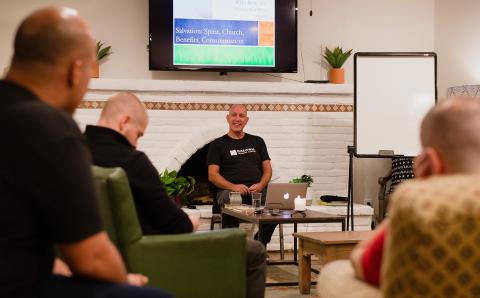Editor’s note: This article is the second in a three-part series on the missional church based on their book, Joining Jesus, by Moses Chung and Chris Meehan.
I (Chris) needed to have abdominal hernia surgery right after the first of the year. Recovering painfully at home, I had lots of time on my hands. Since my belly hurt every time I moved, I needed to go slowly. Meanwhile, I knew that going slowly would be the topic for this article, the second of three I’m writing with my friend, Moses Chung, with whom I co-authored the book Joining Jesus: Ordinary People on the Edges of the Church. At the end of our book, Moses added three words he believes describe vibrant congregations today. Those words are “small,” which we wrote about last month; “slow,” the theme for this month; and “patient,” which we’ll address next month.
So back to going slowly. Nursing my aching stomach, I felt trapped and thought of how poorly I’m able to practice going slowly in my everyday life. My tendency is to barrel ahead, a bull in a china shop. That being true, I wondered: Could I honestly write this article? Should I be the one to promote something I’m so terrible at doing?
I realized I needed help, so I decided to turn to others with more wisdom on the subject. Hobbling my way into my basement library, I found a bunch of books touching on going slowly.
One of the first I read was Seeing Jesus: Visionary Encounters from the First Century to the Present, by Robert Hudson. In the third chapter, Hudson recounts the story in Luke of the first Easter, when two of Christ’s followers were walking the Emmaus road on their way home when they encountered a stranger. As many of us know, the pair spoke at length to this stranger, having no idea who he was, until they reached home and invited him in. Around the dinner table, as the travelers started to settle down from an eventful day, the stranger picked up a loaf of bread and broke it, and suddenly they knew this person was the risen Christ! What happened? Why did they see it was Jesus? Hudson explains that “the Scriptures, from Moses to the prophets, were a slow-motion revelation about the inevitable advent of the Messiah.” Slow-motion, he writes. It takes time. It takes us settling in and going slowly to have that wondrous and healing encounter.
Yet another gem of a book is Stability: How an Ancient Monastic Practice Can Restore Our Relationships, Churches, and Communities, by Nathan Oates. As the title indicates, the book is about remaining rooted—not necessarily going slowly, but about paying attention and staying put. Only by going slowly, though, can we truly and clearly see where we are, what is going on, and what needs to happen. And in this are lessons for the church. Oates writes: “Maybe the answer is for us to restore the church—to choose to be a stabilizing presence in the midst of a very unstable and individualistic culture. Maybe the answer for us is to value staying in this moment, in this place, in this relationship, in this community, instead of getting caught up in the bigger cultural current of constant change.” Like monks in a monastery, Oatessays, we need to develop slow, daily rhythms of prayer and activity, and we don’t need to be constantly on the move.
Directly about our topic is the book Slow Church: Cultivating Community in the Patient Way of Jesus, by C. Christopher Smith and John Pattison. Here is an excerpt describing what “slow church” entails, particularly from the start: “As in any relationship, trust and openness take time. We start as strangers, become acquaintances, but going from acquaintance to relationship/friendship is a slow, mutual journey of getting to know and accept one another—it requires time, intentionality, authenticity and love!”
And here are some comments from Rod Hugen, a retired pastor of the Village Church, a congregation we featured in our book that is located in a former Tucson, Ariz., elementary school. We went there because we had sensed it embodied characteristics we wanted to write about, such as going slowly.
“The world around us is always making harsh demands of us,” Hugen said. “Success is written into everything we do. … It’s wearying. A slowing down becomes a salve to the soul in a weary world. Our calling is to invite the frazzled folks around us to lay down their burdens at Jesus’ feet—and to not pick them up again.”
Seek the Risen Christ
Like Chris, I (Moses) struggle with going slowly in my life and ministry. My calendar is filled with too many to-do lists and appointments, day to day, week to week, and month to month. That’s the reality for many of us living in North America’s frenzied culture, including those in church ministry. To go slowly is a countercultural act.
In many of the stories we wrote in Joining Jesus, I discovered that one common characteristic of those who seemed to exemplify Spirit-led ministry was what I call a “ministry of presence.” They are committed to a specific local place and the people who inhabit that space, and they treat them as if they are their whole world. They were there simply because they felt a call to be there, started to meet people one by one, paid attention to their neighborhoods and the ordinary activities happening around them, and devoted their time and energy to love their neighbors. In short, they were simply available and present to their place and the people there. As they followed one thing to another, without a big agenda, the Holy Spirit wove their lives together with their neighbors’ and eventually birthed vibrant communities of peacemaking, hospitality, and compassion.
Where do we begin to become a countercultural force in this slow, missional movement and join in what God is doing today? What can we try in the places we live our ordinary, everyday lives? We suggest three simple practices of going slowly in our lives and church ministry.
First, start by asking a different question that helps you to value, as Nathan Oates suggests, “staying in this moment, in this place, in this relationship, in this community, instead of getting caught up in the bigger cultural current of constant change.”
Second, invite others—a friend or stranger from your congregation or neighborhood—to your home for a slow dinner-table conversation. Try to schedule a weekly or monthly rhythm of being present to each other around meals.
Third, learn the art of listening well and deeply. Listen with curiosity. Listen to connect and explore, not to correct and instruct. Listen to their joys and pains. Listen as if nothing else matters than what you are hearing at that moment.
God is not in a hurry. Join the slow work of God. And as you go slowly in those ordinary moments of being with the “other,” may the risen Christ reveal himself and meet you in slow motion.
About the Authors
Chris Meehan is a freelance writer and commissioned pastor at Coit Community Church in Grand Rapids, Mich.
Moses Chung is the program and strategy director for Resonate Global Mission and lives in Anaheim, Calif. He co-authored Joining Jesus: Ordinary People at the Edges of the Church (joiningjesusbook.com) with Chris Meehan.









